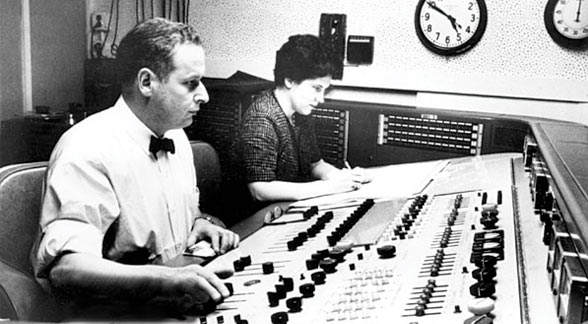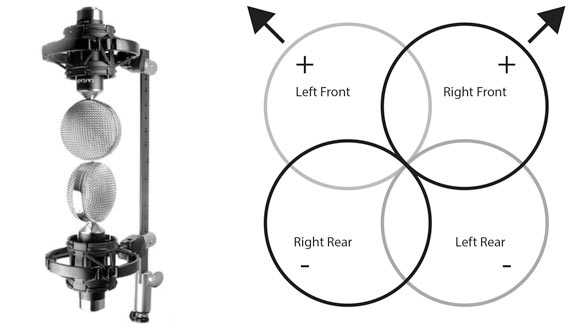Real “Living Presence” Stereo
Alan Blumlein invented stereo in the 1930s. A brilliant young British engineer who was tragically killed in a plane crash, Blumlein was the first to use multiple microphones to capture the spatial spread of an ensemble. He was responsible for both the XY and coincident pair of bidirectional mikes that we refer to as a “Blumlein Pair”. The basic idea behind a Blumlein stereo pair is to place two microphone capsules on top of one another. The directional sensitivity or “polar pattern” of each mic is set to “Figure 8” or “Bi-directional”, meaning they are optimally sensitive from the front and the back. The capsules are oriented at 90 degrees from each other with the centerline splitting the 90 degrees (see diagram below).
Figure 1 – A Blumlein stereo pair consisting of a pair of coincident “figure 8” microphones.
The benefit of capturing a selection of music with this type of microphone arrangement is that it receives the direct sound of the ensemble located in front of the microphone pair AND the ambiance of the performance space behind. Some advocates of this type of recording have termed the technique “True Stereo” and they’ve even concocted a logo and sort of mission statement. Their claim is that this in the only “true” way to capture an ensemble. It is one of many stereo methods and works does work quite well. But it is merely one of many miking techniques that I teach to my students. My own personal preference is for ORTF stereo miking. I’ll talk more about that method in another post.
The Blumlein technique was very popular, as stereo recording became the norm in the late 50s and into the 60s. But it was the innovations brought to classical recordings by the husband and wife team of Robert (Bob) and Wilma Cozart Fine for Mercury Living Presence that resulted in a major advance in the quality of classical records. Initially, they used a single microphone to capture the entire orchestra. After all these were the days of monophonic records (It’s hard for me to imagine how great the sound experience could possibly be with a single channel of information but if that’s what you’ve got then that’s what you’ve got). Eventually Bob refined the technique for his stereo recordings and used a pair of Neumann KM-56s on the sides and a Schoeps M201 in the middle (this is modified spaced pair stereo miking technique). These microphones were placed about 12 feet above the orchestra just behind the conductor. The three tracks were then mixed into a stereo blend.
The stereo recordings by Wilma and Cozart Fine are still cherished today for their sound and the quality of the musical performances. Wilma Cozart Fine, who died in 2009, was tasked with making digital transfers of the original masters (and in some cases the second/third generation safety copies because the original were either lost or damaged), which resulted in a boxed set of some 50 CDs in the 90s.
While I personally refuse to elevate any recording from the 50s and 60s to HD-Audio status (there just isn’t enough dynamic range, frequency response and channels to meet my standards), I did find it very interesting to read the following quote from the Fine’s son about their passion, “It was a realism. They wanted an honesty: the honest sound of the instruments, how they really sounded. They wanted a clarity to everything. They weren’t as interested in sounding like you were in the tenth row as they were in hearing inside the music.” I couldn’t agree more! What better way to get inside the music than to experience a 5.1 surround HD-Audio mix? I would love to have met Bob and Wilma. I think they would be wowed by the improvements that today’s digital equipment provides over the system they struggled with.



… and I think Bob and Wilma went to three M201’s once they could find six of the rarities so they had a full backup set.
IIRC the M201 was anything but a flat-response mic. They specifically chose it because of its significant extra gain in the presence-region frequencies. In a way it is like they wanted a Stage mix rather than an Audience mix — just like you! 😉 And the legendary status of the recordings maybe suggests you are on the right track with the Stage mix, heh heh.